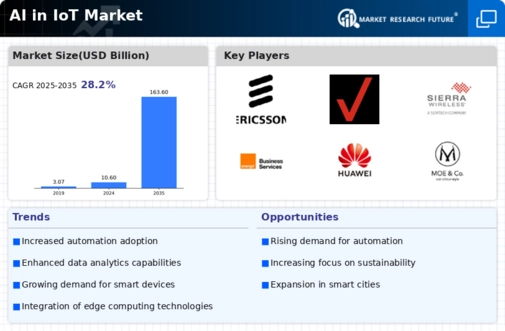Market Analysis
In-depth Analysis of AI in IoT Market Industry Landscape
The internet of things (IoT) AI industry is growing. Market factors that demonstrate the transformational potential of AI and IoT are driving this expansion. The exponential growth of connected devices and the Internet of Things' massive data output are driving this development. As more devices are networked, this enormous data pool must be analyzed for insights. These include industrial sensors and smart home devices. All these gadgets are linked. Artificial intelligence (AI) can analyze enormous information and understand complicated patterns. This makes IoT devices smarter and improves decision-making. Increasing need for decision support systems and real-time data analysis is also driving AI application in the Internet of Things. The velocity and amount of data generated by Internet of Things devices may challenge standard analytics. AI systems, particularly machine learning models, excel in real-time data analysis. In predictive maintenance, AI-powered IoT devices may identify equipment problems before failures, saving downtime and lowering operational costs. Edge computing advances are driving AI-IoT convergence. Local data processing is needed as the number of Internet of Things devices at the network edge grows to reduce latency and bandwidth. Artificial intelligence algorithms at the edge allow Internet of Things devices to make intelligent decisions locally, removing the need for cloud server communication. Thus, this enhances IoT device performance and addresses data privacy and security concerns. The internet of things AI industry is also affected by the growing adoption of AI-driven solutions across industries. Businesses are rapidly using AI to improve operational efficiency, resource allocation, and innovative service delivery. In the Internet of Things (IoT), artificial intelligence algorithms let connected devices learn from data patterns, adapt to changing conditions, and deliver more tailored and context-aware services. AI in the internet of things makes smart homes, healthcare systems, and industrial settings smarter and more responsive, highlighting this versatility. Cost reduction and resource optimization are driving organizations to use AI in IoT for intelligent automation. Companies can automate boring tasks, monitor and regulate processes autonomously, and optimize energy use by integrating AI algorithms into IoT workflows. In smart manufacturing, AI-driven IoT systems may dynamically adjust production schedules based on real-time demand and equipment conditions. Operations are more efficient and waste is reduced. The regulatory climate is also helping the internet of things AI industry grow. As data privacy and security become more important, organizations are turning to AI to secure IoT installations. AI algorithms that detect and respond to security threats in real time may defend Internet of Things devices and networks against assaults. Organizations must build AI-driven security solutions in their Internet of Things ecosystems to meet these objectives.










Leave a Comment